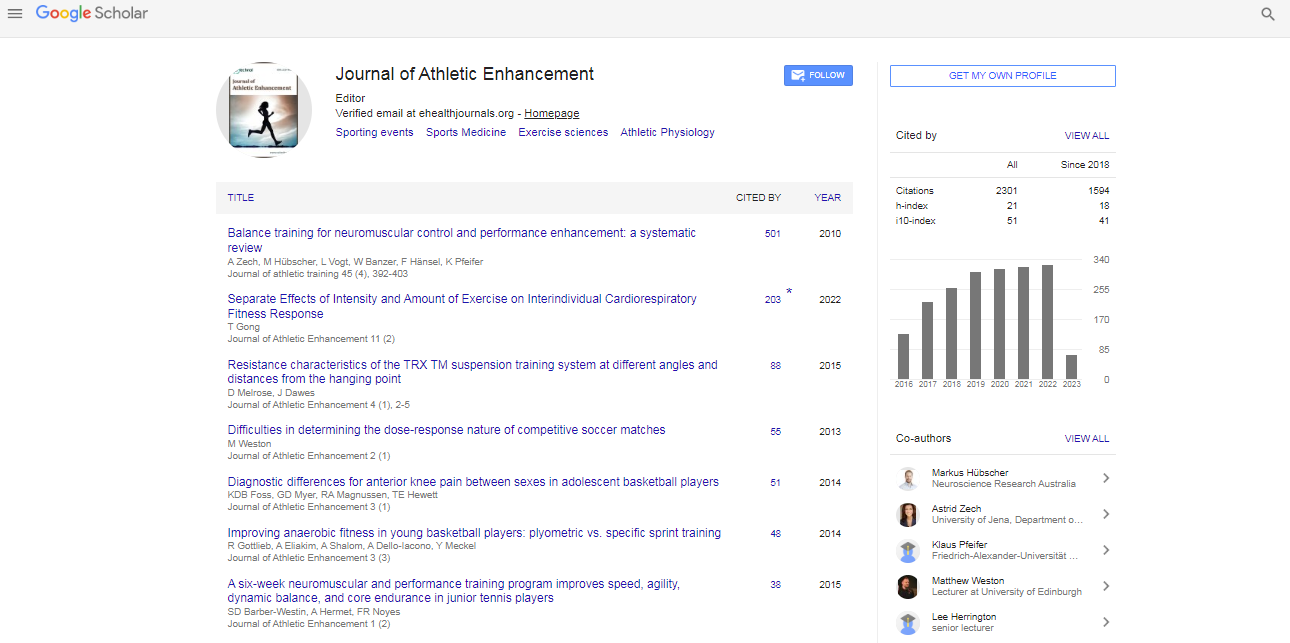Perspective, J Athl Enhanc Vol: 13 Issue: 6
Muscle Injury in Sports: Its Causes, Prevention and Recovery
Barbara Salmon*
1Department of Sports Science, University of the Sunshine Coast, Queensland, Australia
*Corresponding Author: Barbara Salmon,
Department of Sports Science, University
of the Sunshine Coast, Queensland, Australia
E-mail: salmonbarbara@edu.au
Received date: 28 October, 2024, Manuscript No. JAE-24-154378;
Editor assigned date: 31 October, 2024, PreQC No. JAE-24-154378 (PQ);
Reviewed date: 14 November, 2024, QC No. JAE-24-154378;
Revised date: 21 November, 2024, Manuscript No. JAE-24-154378 (R);
Published date: 28 November, 2024 DOI: 10.4172/2324-9080.1000161
Citation: Salmon B (2024) Muscle Injury in Sports: Its Causes, Prevention and Recovery. J Athl Enhanc 13:6.
Description
Muscle injuries are a common concern in sports, ranging from mild strains to severe tears, often affecting athletes across various disciplines. These injuries not only hinder performance but can also lead to extended periods of rehabilitation, limiting an athlete's ability to train or compete. Understanding the causes, prevention strategies and recovery methods for muscle injuries is essential for both athletes and coaches to ensure a safe and effective training environment.
Muscle injuries in sports typically occur when the muscle fibers are stretched or torn due to excessive force or stress. The most common types of muscle injuries are strains, tears and contusions. A muscle strain, also known as a pulled muscle, occurs when the muscle fibers are overstretched or torn. This injury can range from mild, where only a few fibers are affected, to severe, where a significant portion of the muscle is torn. Muscle tears are classified into three grades based on the extent of the damage: Grade 1 (mild) involves minimal tearing with little to no loss of strength, grade 2 (moderate) includes partial muscle tears with a noticeable loss of strength and grade 3 (severe) involves a complete rupture of the muscle, which may require surgical intervention. Muscle contusions, or bruises, are caused by direct trauma to the muscle, leading to bleeding and swelling within the tissue.
The primary cause of muscle injury in sports is overuse or excessive force. When an athlete pushes their muscles beyond their capacity without proper conditioning or rest, the fibers are at risk of tearing. High-impact or high-intensity activities, such as sprinting, jumping, or lifting heavy weights, can place significant strain on muscles. Inadequate warm-up and stretching before exercise can also increase the likelihood of injury, as cold or tight muscles are more susceptible to strains. Additionally, improper technique, such as poor posture or incorrect form during movement, can contribute to muscle injury, as it places undue stress on certain muscle groups. Fatigue is another common factor, as muscles that are tired are more prone to injury due to a reduced ability to absorb shock or handle stress.
Preventing muscle injuries in sports involves a multifaceted approach that includes proper training, conditioning and recovery strategies. A well-structured warm-up routine is important before engaging in any physical activity. Warming up increases blood flow to the muscles, preparing them for the demands of exercise. Stretching, both dynamic before exercise and static afterward, can enhance muscle flexibility and range of motion, reducing the risk of strains.
Proper nutrition also contributes to muscle health and injury prevention. A diet rich in protein, vitamins and minerals helps to support muscle repair and recovery. For example, calcium and vitamin D are important for bone health, while magnesium and potassium help with muscle function and prevent cramps. Staying hydrated is equally important, as dehydration can lead to muscle fatigue, cramping and an increased risk of injury.
Recovery from a muscle injury varies depending on the severity and location of the injury, but it generally follows a similar process. After the initial inflammation and swelling subside, the focus shifts to rehabilitation, which includes gentle stretching and strengthening exercises. A gradual return to activity is essential to prevent re-injury. Athletes should avoid rushing back into competition or intense training, as premature activity can compromise the healing process. A gradual progression, under the guidance of a medical professional or physical therapist, ensures that the muscle has regained sufficient strength and flexibility before being put under stress again.
 Spanish
Spanish  Chinese
Chinese  Russian
Russian  German
German  French
French  Japanese
Japanese  Portuguese
Portuguese  Hindi
Hindi 
